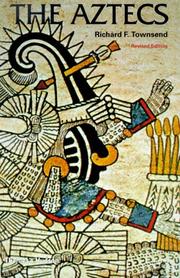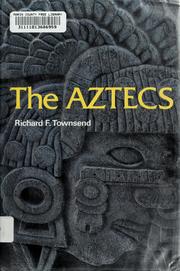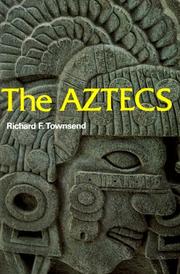| Listing 1 - 10 of 64 | << page >> |
Sort by
|
Book
Year: 1863 Publisher: Dublin : Hodges, Smith, and co.,
Abstract | Keywords | Export | Availability | Bookmark
 Loading...
Loading...Choose an application
- Reference Manager
- EndNote
- RefWorks (Direct export to RefWorks)
Book
ISBN: 9780500287910 0500287910 Year: 2009 Publisher: London Thames and Hudson
Abstract | Keywords | Export | Availability | Bookmark
 Loading...
Loading...Choose an application
- Reference Manager
- EndNote
- RefWorks (Direct export to RefWorks)
Aztecs. --- Aztecs --- Aztec Indians --- Azteca Indians --- Aztecan Indians --- Mexica Indians --- Tenocha Indians --- Indians of Mexico --- Nahuas

ISBN: 0500281327 9780500281321 Year: 2000 Volume: 107 Publisher: London : Thames & Hudson,
Abstract | Keywords | Export | Availability | Bookmark
 Loading...
Loading...Choose an application
- Reference Manager
- EndNote
- RefWorks (Direct export to RefWorks)
Aztecs. --- Aztecs --- History --- Religion --- Social life and customs --- Ethnology. Cultural anthropology --- History of Latin America --- Mexica --- Acolhua --- Tepanec --- Teotihuacán --- Toltec --- Aztec [culture or style] --- Chichimec [culture or style]

ISBN: 0500021139 Year: 1992 Volume: 107 Publisher: London Thames and Hudson
Abstract | Keywords | Export | Availability | Bookmark
 Loading...
Loading...Choose an application
- Reference Manager
- EndNote
- RefWorks (Direct export to RefWorks)
972 --- Aztecs --- Aztec Indians --- Azteca Indians --- Aztecan Indians --- Mexica Indians --- Tenocha Indians --- Indians of Mexico --- Nahuas --- 972 Geschiedenis van Mexico --- Geschiedenis van Mexico --- Aztèques --- History
Book
ISBN: 0865590559 Year: 1984 Publisher: Chicago The Art Institute.
Abstract | Keywords | Export | Availability | Bookmark
 Loading...
Loading...Choose an application
- Reference Manager
- EndNote
- RefWorks (Direct export to RefWorks)
Ethnology. Cultural anthropology --- collecting --- Art, Primitive --- Art --- Art, Occidental --- Art, Visual --- Art, Western (Western countries) --- Arts, Fine --- Arts, Visual --- Fine arts --- Iconography --- Occidental art --- Visual arts --- Western art (Western countries) --- Arts --- Aesthetics --- Exhibitions --- Private collections&delete& --- Private collections
Book
Abstract | Keywords | Export | Availability | Bookmark
 Loading...
Loading...Choose an application
- Reference Manager
- EndNote
- RefWorks (Direct export to RefWorks)

ISBN: 0500277206 Year: 1998 Publisher: London Thames and Hudson
Abstract | Keywords | Export | Availability | Bookmark
 Loading...
Loading...Choose an application
- Reference Manager
- EndNote
- RefWorks (Direct export to RefWorks)
Ethnology. Cultural anthropology --- History of Latin America --- Aztec [culture or style] --- Mexico
Digital
Year: 2016 Publisher: Cambridge, Mass. National Bureau of Economic Research
Abstract | Keywords | Export | Availability | Bookmark
 Loading...
Loading...Choose an application
- Reference Manager
- EndNote
- RefWorks (Direct export to RefWorks)
The dramatic rise in CEO compensation during the 1990s and early 2000s is a longstanding puzzle. In this paper, we show that much of the rise can be explained by a tendency of firms to grant the same number of options each year. Number-rigidity implies that the grant-date value of option awards will grow with firm equity returns, which were very high on average during the tech boom. Further, other forms of CEO compensation did not adjust to offset the dramatic growth in the value of option pay. Number-rigidity in options can also explain the increased dispersion in pay, the difference in growth between the US and other countries, and the increased correlation between pay and firm-specific equity returns. We present evidence that number-rigidity arose from a lack of sophistication about option valuation that is akin to money illusion. We show that regulatory changes requiring transparent expensing of the grant-date value of options led to a decline in number-rigidity and helps explain why executive pay increased less with equity returns during the housing boom in the mid-2000s.
Digital
Year: 2017 Publisher: Cambridge, Mass. National Bureau of Economic Research
Abstract | Keywords | Export | Availability | Bookmark
 Loading...
Loading...Choose an application
- Reference Manager
- EndNote
- RefWorks (Direct export to RefWorks)
We examine how an increase in stock option grants affects CEO risk-taking. The overall net effect of option grants is theoretically ambiguous for risk-averse CEOs. To overcome the endogeneity of option grants, we exploit institutional features of multi-year compensation plans, which generate two distinct types of variation in the timing of when large increases in new at-the-money options are granted. We find that, given average grant levels during our sample period, a 10 percent increase in new options granted leads to a 2.8-4.2 percent increase in equity volatility. This increase in risk is driven largely by increased leverage.
Book
ISBN: 9023818245 0861589122 Year: 1985 Publisher: Leiden Spruyt, Van Mantgem & De Does B.V.
Abstract | Keywords | Export | Availability | Bookmark
 Loading...
Loading...Choose an application
- Reference Manager
- EndNote
- RefWorks (Direct export to RefWorks)
| Listing 1 - 10 of 64 | << page >> |
Sort by
|

 Search
Search Feedback
Feedback About UniCat
About UniCat  Help
Help News
News